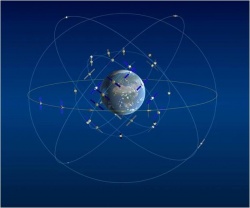If you wish to contribute or participate in the discussions about articles you are invited to contact the Editor
BeiDou Space Segment
| BEIDOU | |
|---|---|
| Title | BeiDou Space Segment |
| Edited by | GMV |
| Level | Basic |
| Year of Publication | 2011 |
The BeiDou Space Segment consists of a constellation of 35 satellites, which include 5 geostationary orbit (GEO) satellites and 30 non-GSO satellites. The system is currently under development evolving from a regional system called BeiDou-1, and in the first phase will provide global navigation services by 2020, similarly to the GPS, GLONASS or Galileo systems.
BeiDou Space Segment
The BeiDou Space Segment will consist of a constellation of 35 satellites, which include 5 geostationary orbit (GEO) satellites and 30 non-GSO satellites; 27 in Medium Earth Orbit (MEO) and 3 in Inclined Geosynchronous Orbit (IGSO), with a worldwide coverage.[1][2]
As of December 2011, the Initial Operation Service was officially declared providing initial passive positioning navigation and timing services for China service area[2].
The nominal constellation includes 35 satellites, 5 GEOs, 3 IGSOs and 27 MEOs. The number of IGSO orbits is 3, with one IGSO per plane. The intersection node is 118E. The MEOs are deployed as a Walker constellation; 24 MEOs in 3 planes plus 3 spares. The orbital parameters of the final constellation are shown in the following table:[1]
| Orbit parmts. | GEO | IGSO | MEO |
|---|---|---|---|
| Semi-Major Axis (Km) | 42164 | 42164 | 27878 |
| Eccentricity | 0 | 0 | 0 |
| Inclination (deg) | 0 | 55 | 55 |
| RAAN (deg) | 158.75E, 180E, 210.5E, 240E,260E | 218E,98E,338E | -- |
| Argument Perigee | 0 | 0 | |
| Mean anomaly (deg) | 0 | 218E:0,98E:120,338E:240 | |
| # Sats | 5 | 3 | 27 |
| # Planes | 1 | 3 | 3 |
References
- ^ a b China Satellite Navigation Office, Development of BeiDou Navigation Satellite System, Munich Satellite Navigation Summit, 2011
- ^ a b BeiDou Navigation Satellite System in Wikipedia

